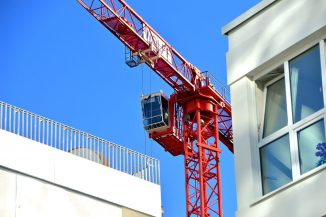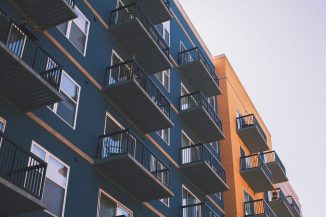
1. What is an external wall system?
The external wall system is made up of the outside wall of a residential building, including cladding, insulation, fire break systems, etc.
2. What is the EWS1 process/ form?
The EWS1 form is designed to be used for residential properties such as blocks of flats (including those owned by housing associations and social housing providers as well as privately owned), student accommodation, dormitories, assisted living, care homes and Houses in Multiple Occupation (HMOs).
The EWS1 form is not specifically designed for use of short-term accommodation such as hotels. EWS1 does, however, apply to an entire building or block so where required, may also be relevant to mixed use.
The EWS process, and resulting form, is a set way for a building owner to confirm that an external wall system on residential buildings has been assessed for safety by a suitable expert, in line with government guidance.
The EWS1 process delivers assurance for lenders, valuers, residents, buyers and sellers. The process was developed through extensive consultation with a wide range of stakeholders including fire engineers, lenders, insurers, valuers, and other cross industry representatives.
The process itself involves a “qualified professional” (see download on this page) conducting a fire-risk assessment on the external wall system, before signing an EWS1 form, which is valid for the entire building for five years.
The form was originally designed following Government advice regarding external wall systems on buildings above 18m and was created to ensure residential buildings over 18m tall could be assessed for safety to allow lenders to offer mortgages. Changes in Government advice in January 2020, brought all residential buildings potentially within scope.
However not every building will require an EWS1 form. RICS has published guidance for valuers on 8 March 2021 and will be working with UK government and other stakeholders to ensure the guidance is implemented by 5 April 2021 and this guidance includes criteria that will be used to help decide whether a particular building should need an EWS1 form. Valuers will always need to follow instructions given by their lender clients.
The criteria considers the height of the building, the type of cladding and (in some circumstances) how much of it there is on the building. There are also criteria relating to balconies and combustible material. You should always have a rationale to justify the request for the EWS1 form.
3. Does the publication of the revised EWS1 form on 8 March 2021, render any existing completed EWS1 forms obsolete?
No, they remain valid until such time as a new EWS1 form is completed.
4. Does each flat/ apartment have to get an individual EWS1 form for selling, buying, or re-mortgaging?
No. Each EWS1 form is valid for an entire block/ building. It is valid for five years.
5. How does the EWS1 form factor into the buying, selling or re-mortgaging of a flat/ apartment?
The EWS (external wall system) process, is agreed by representatives for developers, managing agents, fire engineers, lawyers, lenders, insurers, and valuers, and has been adopted across the industry.
Its purpose is to ensure that a valuation can be provided for a mortgage or re-mortgage on a property which features an external wall cladding system of uncertain make up, something that has both safety implications and which may affect value if remediation is required due to the fire risk associated.
The process results in a signed EWS1 form per building, with two options/ outcomes:
(A) external wall materials are unlikely to support combustion
(B) Combustible materials are present in an external wall with sub options of either, fire risk is sufficiently low that no remedial works are required, or fire risk is high enough that remedial works are required.
The EWS1 form itself certifies that the external wall cladding system has been assessed by someone who is suitably qualified to do so. A list of suggested bodies for a building owner or their agents to contact to source fire experts can be found here.
While the form applies to residential buildings, changes in Government advice introduced in January 2020, mean that all residential buildings of any height with a wall system may need to be risk assessed. RICS has produced guidance to help valuers decide when an EWS1 form should be required.
It is also important to note what the form will not do. It is not a life safety certificate. It is only for the use of a valuer and lender in determining if remediation costs affect value. Where a building is found to need remedial works this will need to be carried out by the building owner, to ensure safety of the building, before a mortgage can proceed unless the lender agrees otherwise.
RICS welcomed the Secretary of State announcement in February 2021,on the additional funding for the removal of dangerous cladding in all qualifying residential properties over 18m. Government funding is something RICS have long called for, and whilst we recognise the complexity of the funding mechanisms, it is critical that any loan scheme for sub-18m blocks should be affordable and viable.
6. If the building owner has not proactively tested the external wall materials what does the seller need to do?
The seller can request that their building owner or managing agent commission an EWS assessment, and / or enquire as to the make-up of the wall system. The building owner or managing agent is responsible for confirming what materials are on their building, and in respect to the EWS1 form, the person responsible for the building needs to confirm what the wall system is made up of and whether an assessment is required.
7. Can the buyer or seller initiate the EWS process if the building owner has not?
The EWS process/ form is for building owners to undertake. Both sellers and buyers should be in contact with the building owner or their agent to ensure this takes place as quickly as possible.
8. If the building owner will not undertake the required assessment, what can the owner/lender/valuer do?
If the building owner does not acknowledge their responsibility and refuses to undertake the necessary assessment, the local council can provide further advice, or it should be referred to the Fire and Rescue Service. No one should be living in a building which is unsafe, and the building owners are the only ones who can progress this.
Building owners have a clear responsibility reinforced by MHCLG advice to arrange for the wall system to be checked and therefore have a route to remediation where needed. Leaseholders should continue to engage with the building owner or their managing agent to ensure this happens.
RICS is working with Government and other stakeholders as part of the Fire Safety Bill, which is due to gain Royal Assent in 2021
9. Who carries out the EWS assessment, and what is their expertise?
The EWS1 form must be completed by a fully qualified member of a relevant professional body within the construction industry with sufficient expertise to identify the relevant materials within the external wall cladding and attachments, including whether fire resisting cavity barriers and fire stopping have been installed correctly.
In addition, in January 2021, RICS launched a new training programme for chartered building surveyors and chartered building control surveyors, to enable them to undertake external wall system assessments for low to medium rise residential buildings. The newly qualified professionals will help increase the number of professionals qualified to carry out such assessments and support the current market demand. Buildings over 18m or those which are high risk and require specialist testing will still require a qualified fire safety engineer.
We have been made aware that unqualified people may be signing off EWS1 forms. RICS condemns anyone using the current situation for their own personal gain, with potentially dangerous consequences for residents, and would urge that any further information related to this is made available to trading standards and RICS if appropriate.
UK banks and building societies have robust measures in place to protect people against fraud, which would pick up any EWS1 form that is suspicious, but we encourage everyone to check the signatory on a form with the profession’s institution. If an RICS member is completing your EWS1 form, you can check their membership with us on our website. There is a list of suggested bodies to contact to source fire experts. This list is not exhaustive, nor does it constitute an endorsement or approval from RICS, UKF or BSA, and other bodies with relevant expertise may be able to assist. Anybody instructing an EWS1 form must be satisfied that the signatory meets the requirements as described above.
10. How will the assessment be carried out?
This is up to the expert undertaking the assessment, but it must include evidence of the fire performance of materials used in the cladding.
While paperwork submitted by the building’s original developer and/or owner can form part of the evidence, it cannot be solely relied upon. Photo evidence of the cladding will be required, or a physical inspection where this is not available or inconclusive.
In some cases – even where all attempts to establish the cladding system have been taken – the make-up and composition of the external wall system may still be unclear. In such instances intrusive tests may be required, alongside a more detailed review by a professional of a higher level of expertise.
Such tests may involve a hole being drilled into the wall or a section of cladding to identify the external wall system materials and their composition. It is crucially important to identify the whole make-up of the external wall system and how it has been installed.
11. Why is an EWS assessment required every five years?
An EWS assessment is required every five years for each building or block. This means multiple sellers located in one block can use the same assessment to assist with the sale of their property.
Five years is intended to capture any renovation or adaptation work done to the building, as well as maintenance over that period.
However, a new EWS assessment may be required within the five-year period if substantial works have been completed to a property, affecting the original conclusions.
When the Fire Safety Bill comes into force, the building owners of all multi-storey, multi-occupied buildings in England will be required to undertake fire risk appraisals and assessments of their buildings, which includes, where appropriate, an assessment of the external wall system.
12. What happens if the EWS assessment identifies that remedial works are required?
If an external wall system requires remedial work then we would expect the valuer to take this into consideration in their valuation. A valuation will only be possible if there is clarity on cost of the work and a timeline for works to be completed. Lenders are unlikely to lend until remedial work has been completed, but some may choose to do so with retentions and the like based on their own risk appetite.
The EWS assessment is for the building owner to oversee, but the resulting form should be available on request to all occupants in that block in the interests of transparency.
RICS welcomed the Secretary of State announcement in February 2021,on the additional funding for the removal of dangerous cladding in all qualifying residential properties over 18m. Upfront government funding is something RICS have long called for, and whilst we recognise the complexity of the funding mechanisms, it is critical that any loan scheme for sub-18m blocks should be affordable and viable.
13. Does the EWS assessment cover general fire safety measures?
The EWS1 form assessment is to be carried out for valuation purposes only. It’s about the safety of different types of external wall systems used in residential buildings located across the United Kingdom and will determine whether or not remedial works are required, thereby affecting value. It is not designed to assess other fire safety features or risks and should never be used to determine the overall risk of fire to a building. It is not a life safety certificate.
The person responsible for the building (Responsible Person under the Regulatory Reform (Fire Safety) Order 2005) should have a fire risk assessment (FRA) for the building as this is an independent legal requirement that is already in place and does not commonly incorporate assessment of external wall materials. Note this will change with the Fire Safety Bill coming into force in England and FRAs will then need to cover the external cladding.
14. Does a nil valuation mean a flat is worthless?
No. ‘Nil valuations’ are used in the process of valuing a property for mortgage lending purposes, where a valuer is unable to provide a value at that moment in time i.e. when the valuers’ inspection takes place due to insufficient information being available. Often a nil valuation signals that the lender requires further information before a valuation can be made, rather than a property being unsellable.
15. Why are lenders asking for EWS1 forms below 18m?
Changes in Government advice in January 2020, bringing all residential buildings into scope, mean some residential buildings below 18m may now require an EWS1 form. For buildings of five or six storeys, there could be a significant amount of cladding on the building, or a check could be due to the types of panels on the building. For buildings of four storeys or fewer, there may be present the most dangerous types of cladding present. The guidance note for Valuers provides information on criteria where an EWS1 should be required.
A valuer should always have a rationale to justify the request for the EWS1 form.
16. Is the EWS1 form stopping homeowners from selling their flats?
EWS1 form assessments are not the cause of people finding themselves unable to move. In fact, they are helping to keep the home buying and selling market from stalling in exceptional circumstances.
Following Grenfell it became apparent, despite having building regulation certification, buildings may have safety concerns. This halted the market in some areas largely over concerns about the extent of future costs of remedial works, and where they would fall. The EWS1 form review process was introduced jointly by RICS and the two key UK mortgage lending bodies, to inform buyers, owners, lenders and valuers on the extent of works needed on the highest risk properties.
However, since the introduction of the EWS1 form, MHCLG advice to check a wall system has extended beyond the original scope, increasing the number of buildings needing checks.
Some of the issues arising from this change have now been addressed and eased following the latest RICS guidance , which clarifies where EWS1 forms are needed. Given the relatively small pool of fire engineers that are competent and have sufficient insurance to allow them to undertake these reviews, delays are unfortunately occurring in some cases (See Q16 for more on the RICS training course). However, the latest guidance should result in fewer EWS1 form requests which will enable the fire engineers to focus on the high-risk buildings. Ultimately, the EWS1 form process provides much-needed clarity around where works are required, avoids financial loss and helps to keep people safe.
RICS Training to increase the number of professionals available to carry out EWS1 checks
17. How many more qualified chartered professionals will this course provide?
RICS has secured government funding to train up to 2,000 professionals within six months. Since its launch in late January 2021, the response has been very positive and we have enrolled professionals in the RICS EWS Assessment training programme. There are currently around 500 professionals progressing through the training.
There are a number of factors that will help drive this number including the solution for accessing professional indemnity insurance (PII) that is being developed by the Government and key industry stakeholders.
18. Will you be able to train all these professionals without professional indemnity insurance (PII)?
The training will continue to progress, so yes RICS can continue to train them, it would be completing the forms post training that would be affected by PII. PII is an essential consumer protection mechanism.
However, the Government have recently committed to developing a Government backed indemnity scheme for professionals completing EWS assessments.
The scheme will be open to professionals who successfully complete the RICS’ External Wall System Assessment training. Building on our efforts so far to help develop the indemnity scheme, we will continue to work closely with all parties to ensure that the Government deliver an appropriate and affordable scheme.





